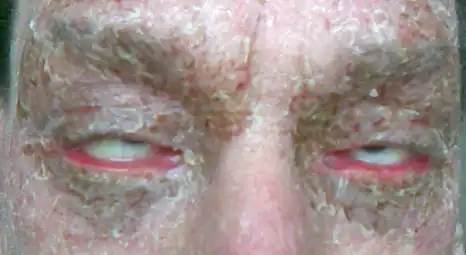Ectropion
| Ectropion | |
|---|---|
 | |
| Cycatricial ectropion of lower lids - eyes open | |
| Specialty | Opthalmology, dermatology |
Ectropion is a medical condition in which the lower eyelid turns outwards. It is one of the notable aspects of newborns exhibiting congenital Harlequin-type ichthyosis, but ectropion can occur due to any weakening of tissue of the lower eyelid. The condition can be repaired surgically. Ectropion is also found in dogs as a genetic disorder in certain breeds.
Signs and symptoms
The clinical presentation of Ectropion is consistent with:[1]
- Painful eyes
- Epiphora
- Chronic conjunctivitis
- Keratitis
 Bilateral upper lid ectropion (with collodion membrane)
Bilateral upper lid ectropion (with collodion membrane) Cycatricial ectropion - closed eyes
Cycatricial ectropion - closed eyes
Causes
- Congenital
- Aging
- Scarring
- Mechanical
- Allergic
- Facial nerve palsy
- Anti-cancer treatments such as erlotinib, cetuximab, and panitumumab, which block the function of EGFR (the epidermal growth factor receptor).
Diagnosis
Ectropion can usually be diagnosed with a routine eye exam and physical. The eyelid's muscle tone and tightness can be assessed by pulling gently on the eyelid.[2]
Treatment
In terms of management the following is done in affected individuals:[1]
- Artificial tears
- Ointment
- Surgery
Other animals
Ectropion in dogs usually involves the lower eyelid. Often the condition has no symptoms, but tearing and conjunctivitis may be seen. Breeds associated with ectropion include the Cocker Spaniel, the Saint Bernard, the Bloodhound, the Clumber Spaniel, and the Basset Hound.[3] It can also result from trauma or nerve damage. Treatment (surgery) is recommended only if there is chronic conjunctivitis or if there is corneal damage. A small part of the affected lid is removed and then the lid is sewn back together.
See also
References
- 1 2 "Ectropion: MedlinePlus Medical Encyclopedia". medlineplus.gov. Archived from the original on 1 February 2022. Retrieved 24 August 2022.
- ↑ "Ectropion: Causes, Symptoms & Complications". Healthline. Archived from the original on 2019-12-21. Retrieved 2019-12-21.
- ↑ Gelatt, Kirk N. (ed.) (1999). Veterinary Ophthalmology (3rd ed.). Lippincott, Williams & Wilkins. ISBN 0-683-30076-8.
External links
| Classification | |
|---|---|
| External resources |